Ball Bearing Cages & Retainers
The ball bearing cage (also known as a ball bearing retainer or ball separator – these are used interchangeably), is the component in a ball bearing that separates the balls, maintains the balls symmetrical radial spacing, and in most cases, holds the bearings together. Cages can also be utilized in providing lubrication by acting as a reservoir for oils, or by supplying a solid film via the cage material itself or a coating on the cage. The designer’s selection of the appropriate cage design for the application is essential in achieving the desired life and performance of the bearing.
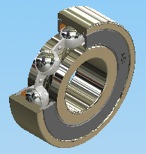
Ball bearing cages are guided by one of the available surfaces between the inner and outer rings. There are inner land riding retainers where the retainer’s bore slides, or is guided by, the O.D. of the inner ring, Outer land riding retainers where the O.D. of the retainer slides, or is guided by, the bore of the outer ring, and ball riding retainers where the retainers touch neither ring and is totally guided by the balls.
Unfortunately, all cages produce frictional forces that increase the starting and running torque in the bearing due to their rubbing contact. As a result, cages are available in a variety of configurations and materials that enhance performance in torque sensitive applications, at higher speeds, or in extreme environments. Some designs are limited in use in certain types of bearings depending on the size and configuration of the bearing. However, there are four basic types of cages that are the most common, readily available, and will perform well in most applications. The four types of cages are the J-type, W-type, RJ-type, and TW-type. Each cage is described in detail below in addition to some of the other less commonly used ball bearing retainer types.
Ball Bearing Cage Types
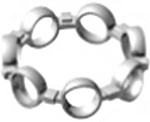 |
“J” Type: Two piece ribbon consisting of two halves that are assembled one half from one side, and the other half from the opposite side. Fold down tabs secure the two halves. This type of cage is guided by the balls. “Loose” clinch type provides lower torque. Material is type 302 stainless steel. Brass and carbon steel are also available. These types of cages can operate at low to moderately high speeds. Loose crimp is standard. Tight crimp (JF) is used for higher speeds. Extra loose (JL) is used for low torque applications. |
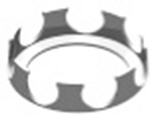 |
“W” Type: One piece steel crown. Mainly used in very small bearings. This type of cage is inner ring guided. Material is type 410 stainless steel. The cage snaps in from one side over the balls. It has excellent performance in low torque, low speed applications. Generally, the one piece steel crown is not used in high speed applications. |
 |
“RJ” Type: This type of cage is suitable for larger bearings (bore diameters over 10mm) with high load carrying capacities. It is a two piece ribbon consisting of two halves that are assembled one half from one side, and the other half from the opposite side. The two pieces are riveted together and are strong enough to with stand higher levels of vibration and acceleration. This type of cage is guided by the balls. Material is type 302 stainless steel or carbon steel sheet. |
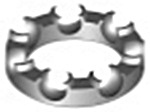 |
”TW” Type: Molded nylon cage. Reduces fluctuations in running torque and is suitable for high speeds. This type of cage is guided by the balls. The operating temperature range is from -30º C to +120º C. Also, available with a glass fiber reinforced nylon that is more rigid and capable of higher speeds. |
As previously mentioned, more highly engineered types of cages are available for low torque, high speed,and/or environmental conditions. Some types of cages are only available in certain sizes or types of bearings.
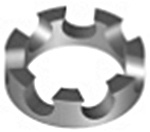 |
“THB” or “THA” Type: Phenolic resin machined one-piece snap in crown type. These retainers have high rigidity and emergency running characteristics. Can be vacuum impregnated with oil. These are used in high speed deep groove ball bearings. “A” designation is for outer ring guided, and “B” designation is for inner ring guided. The operating temperature range is from -50º C to +140º C. |
 |
“TxHB” or “TxHA” Type: Machined one-piece snap in crown type made from special materials. These retainers have high rigidity and emergency running characteristics. These are used in high speed deep groove ball bearings. “A” designation is for outer ring guided, and “B” designation is for inner ring guided. The operating temperature range is from -50º C to +260º C depending on the material. “x” is a number code for the special material. |
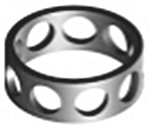 |
“TA” or “TB” Type: One piece full machined type made of phenolic resin material. These retainers have high rigidity and emergency running characteristics. Can be vacuum impregnated with oil. These are used in angular contact bearings only. “A” designation is for outer ring guided, and “B” designation is for inner ring guided. The operating temperature range is from -50º C to +140º C. |
 |
“TxA” or “TxB” Type: One piece full machined type made from special materials. These retainers have high rigidity and emergency running characteristics. These are used in AC type bearings only. “A” designation is for outer ring guided, and “B” designation is for inner ring guided. The operating temperature range is from -50º C to +260º C depending on the material. “x” is a number code for the special material. |
v
The code “V” is used to designate a full complement of balls. This type of bearing has no cage, but a maximum number of balls. These bearings have a filling slot in either the outer or inner ring (sometimes both) so they can only take a thrust load in one direction. This type is suitable for high radial loads, high axial loads (one direction), but only with low to medium speeds.
Special Materials for Ball Bearing Cages:
Phenolic Resin - Retainers are manufactured from linen and or paper based phenolic materials because of their ability to absorb oil lubricants. During bearing operation the lubricants are wicked or forced out of the retainers due to G-forces, which provides extra lubricant to the rolling and sliding elements. The phenolic materials are manufactured from linen or paper sheets that are coated with a phenyl formaldehyde resin which are rolled into tubes under high heat, tension, and pressure.
Phenolic tubes for ball bearing retainers should be formed with less tension and pressure than the tubes manufactured for structural end use. This is done to assure that the paper and linen fibers are not completely filled with the resin, leaving virgin paper or linen available to absorb and act as a reservoir for oil lubricants. The retainers are then machined from the tubes.
Vacuum Impregnation - Prior to assembly into the bearing, the retainers are meticulously cleaned and placed into a vacuum chamber along with a container of the oil lubricant. A hard vacuum is drawn and the chamber is heated to approximately 1,200°F. The vacuum and heat draws out any air and moisture from the retainers and degasses the oil. While maintaining a vacuum the retainers are covered with the degassed oil. The container is then introduced to atmospheric pressure, which forces the oil into the virgin paper or linen materials. The retainers are then assembled into bearings. Some customers will request that the bearings must be subjected to low centrifugal forces to remove excess surface oil.
Cages, or retainers, can also be manufactured from sacrificial solid lubricants: Ball bearing retainers manufactured from Teflon, PGM or Salox M are extremely expensive and are used only in very specialized expensive equipment. Normally they are used in hard vacuum and outer space type applications. Both PGM and Teflon retainers have been used extensively in slow speed torque sensitive applications such as flow meters.
Materials for TxA, TxB, TxHB, and TxHA:
T9NH = Synthetic Molded Glass Fiber Reinforced. Higher Speed than “TNH”. More Strength. Temp Range -30°C TO 120°C plus.
THB = Linen Based Phenolic
T1HB = Paper Based Phenolic (for starting torque better than linen)
T2HB = (not used)
T4HB = Torlon 4301. 12% Graphite, 3% PTFE
T5HB = (not used)
T6HB = (not used)
T7HB = Torlon 4203
T8HB = Pure PTFE (used with ceramic bearings in highly corrosive environments)
T9HB = PA 6.6 WITH 25% Glass Fibers
Properly Designed Ball Bearing Retainers:
Definitions: For two piece steel ribbon retainers, Tabs (ears) are the protrusions on the male half of a ribbon retainer that is clinched over the female half to hold them together.
Ball Pocket: The part of the retainer that surrounds and positions the ball. The diametrical clearance between the ball and the ball pockets can be as small as 0.0035” in miniature and instrument bearings and can be upwards of 0.010” in larger bearings.
Slot: For crown type retainers, the slot is the opening that the ball passes thru (during bearing assembly) prior to entering the ball pocket.
Properly designed retainers will have the ball touch the ball pocket exactly on the pitch circle of the balls. Should contact be made above or below the pitch circle, you could statically experience retainer hang-up and dynamically experience running torque spikes.
The only time that the surface finish becomes an issue regarding retainers is when you have a land-riding retainer. The surface of the retainer that is touching the land should be ground. Retainers should be properly de-burred.
Coined ball pocket: In metallic crown ball bearing retainers: An oversized ball is drawn through the blank ball pocket to form a spherical surface for the balls to contact. The retainer is then hardened so the retainer can be snapped into the bearing without permanently deforming the ears.
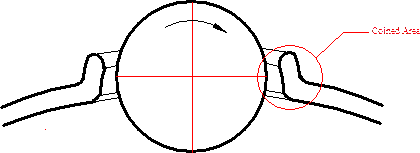
Loose Clinch (Crimp): Ribbon retainers should be loosely clinched so that the balls can orient the two rettainer halves. The loose clinch provides for less noise as well as lower runner and starting torque.
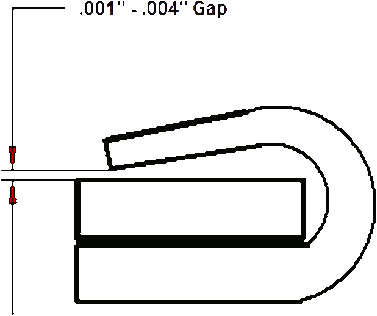
Ball Bearing Retainer Performance Problems
Hooping: Is the phenomena when the retainer wobbles like a hula-hoop causing torque spikes in the rotating assembly. The retainer should track in a true circumferential plane concentric with the pitch diameter of the balls.
Hang-up (Wind-up): When an axial load is applied to static bearings, that have the axis of their shaft in a horizontal mode, the balls fall downward to a position where they are unequally spaced prior to the load being applied. When the axial load is applied it squeezes the balls between the inner and outer raceways. Now that the balls are held securely in unequally spaced positions they cause the retainer to bind. This binding is called "retainer hang-up." Once bearing rotation commences the retainer is stressed and some of the balls may skid causing damage that will initiate premature bearing failure.

